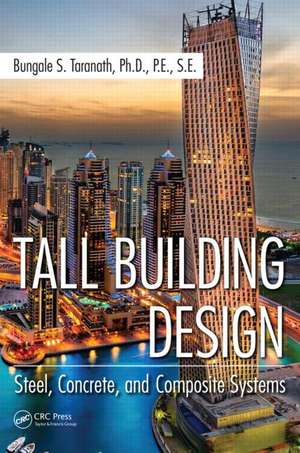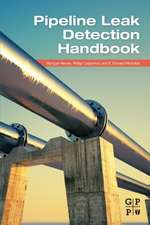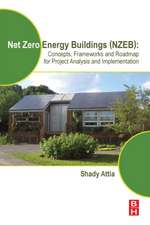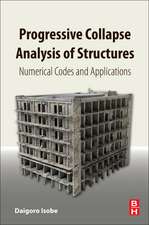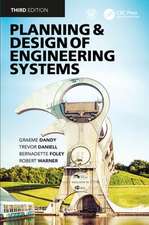Tall Building Design: Steel, Concrete, and Composite Systems
Autor Bungale S. Taranathen Limba Engleză Hardback – 14 iul 2016
Offering guidance on how to use code-based procedures while at the same time providing an understanding of why provisions are necessary, Tall Building Design: Steel, Concrete, and Composite Systems methodically explores the structural behavior of steel, concrete, and composite members and systems. This text establishes the notion that design is a creative process, and not just an execution of framing proposals. It cultivates imaginative approaches by presenting examples specifically related to essential building codes and standards. Tying together precision and accuracy—it also bridges the gap between two design approaches—one based on initiative skill and the other based on computer skill.
The book explains loads and load combinations typically used in building design, explores methods for determining design wind loads using the provisions of ASCE 7-10, and examines wind tunnel procedures. It defines conceptual seismic design, as the avoidance or minimization of problems created by the effects of seismic excitation. It introduces the concept of performance-based design (PBD). It also addresses serviceability considerations, prediction of tall building motions, damping devices, seismic isolation, blast-resistant design, and progressive collapse. The final chapters explain gravity and lateral systems for steel, concrete, and composite buildings.
The Book Also Considers:
- Preliminary analysis and design techniques
- The structural rehabilitation of seismically vulnerable steel and concrete buildings
- Design differences between code-sponsored approaches
- The concept of ductility trade-off for strength
Preț: 1322.19 lei
Preț vechi: 1612.43 lei
-18% Nou
Puncte Express: 1983
Preț estimativ în valută:
253.03€ • 263.19$ • 208.89£
253.03€ • 263.19$ • 208.89£
Carte tipărită la comandă
Livrare economică 14-28 aprilie
Preluare comenzi: 021 569.72.76
Specificații
ISBN-13: 9781466556201
ISBN-10: 146655620X
Pagini: 872
Ilustrații: 794 black & white illustrations, 62 black & white tables
Dimensiuni: 178 x 254 x 56 mm
Greutate: 1.88 kg
Ediția:1
Editura: CRC Press
Colecția CRC Press
ISBN-10: 146655620X
Pagini: 872
Ilustrații: 794 black & white illustrations, 62 black & white tables
Dimensiuni: 178 x 254 x 56 mm
Greutate: 1.88 kg
Ediția:1
Editura: CRC Press
Colecția CRC Press
Public țintă
Academic and Professional Practice & DevelopmentCuprins
Loads on Building Structures. Wind Loads. Earthquake Effects on Buildings. Wind Design with Particular Reference to ASCE 7-10. Seismic Design with Particular Reference to ASCE 7-10 Seismic Provisions. Performance-Based Design. Preliminary Calculations to Ensure Validity of Computer Analysis. Seismic Evaluation and Rehabilitation of Existing Buildings. Special Topics. Torsion. Seismic Design: A Pictorial Review. Steel Buildings: Bolted and Welded Connections, Gravity, and Lateral Load-Resisting Systems and Details. Reinforced Concrete Buildings: Structural System and Details. Composite Buildings: Structural System and Details. Bibliography. Index.
Recenzii
"This book is an outstanding, comprehensive resource for all aspects of tall building design. I particularly appreciate the marriage of theory and practicality by having the foundation be a conceptual understanding that is then reinforced by code-based applications. This fact is what makes great engineers. Although it is a substantial text, it is not intimidating and is easily approached by new and advanced students. It is a text that students will want in their library as they move into their design careers."
—David Naish, Assistant Professor, California State University Fullerton, USA
"… one of the most comprehensive books covering structural design of high-rise buildings. Examples from the writer’s rich experiences are beneficial for young structural engineers."
—Sang Dae Kim, Korea University, Seoul, South Korea
"Not only do I want to have it on the shelf, but also use it as a required textbook for my graduate course and technical electives. Dr. Taranath clearly demonstrates superior knowledge of building codes especially as it relates to wind engineering and earthquake engineering."
—Dr. Hany J. Farran, professor of structural engineering, Cal Poly Pomona, California, USA
—David Naish, Assistant Professor, California State University Fullerton, USA
"… one of the most comprehensive books covering structural design of high-rise buildings. Examples from the writer’s rich experiences are beneficial for young structural engineers."
—Sang Dae Kim, Korea University, Seoul, South Korea
"Not only do I want to have it on the shelf, but also use it as a required textbook for my graduate course and technical electives. Dr. Taranath clearly demonstrates superior knowledge of building codes especially as it relates to wind engineering and earthquake engineering."
—Dr. Hany J. Farran, professor of structural engineering, Cal Poly Pomona, California, USA
Notă biografică
Dr. Bungale S. Taranath, PhD, PE, SE, had extensive experience in the design of concrete, steel, and composite tall buildings. He was a member of the American Society of Civil Engineers and the Concrete Institute, as well as a registered structural and professional engineer in several states. The author of a number of published papers on torsion analysis and multistory construction projects, Dr. Taranath published five books, three of which were translated into Chinese and Korean and are widely referenced throughout Asia. He also conducted seminars on tall building design in the United States, China, Hong Kong, Singapore, Mexico, India, and England.
Descriere
This book examines the behavior of structural members and systems to aid in the structural design of tall buildings in conjunction with the latest building codes. These code provisions are subject to change periodically. Familiarity with current methodologies is essential to designing structures that comply with legally adapted standards in a safe, economic, and efficient manner. However, the first nine chapters explain the fundamental principles of structural engineering in such a manner as to be entirely independent of code regulations.
